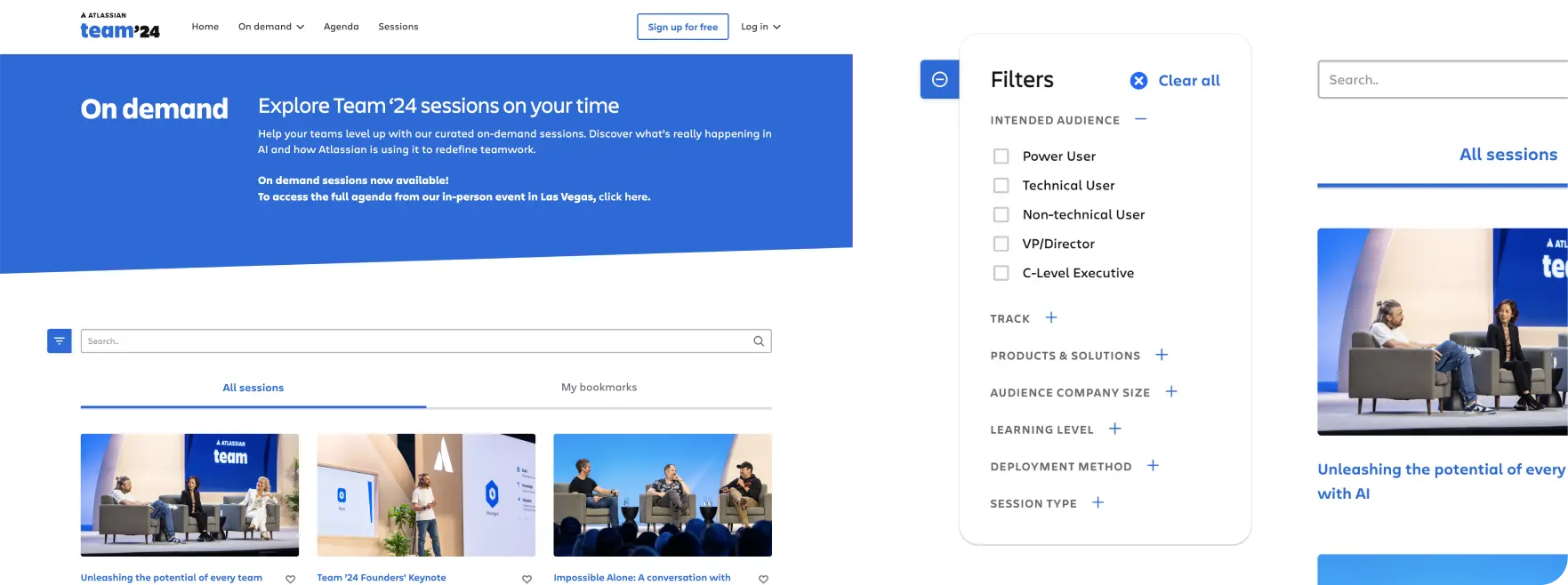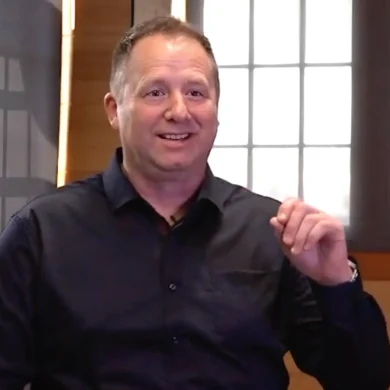“We’re trying to design even better experiences so people will love coming to our events, and love coming back.”Josh Shepherd, Head of Event Technology and Innovation at Atlassian
Scale, content, and community.
Those are the three things Josh Shepherd, Head of Event Technology and Innovation at Atlassian, has top of mind when he looks at his portfolio of events.
And while on the surface it may not seem like those three pillars have much in common, Josh and his team are on a mission that brings all three together.
“We’re on a huge data quest right now,” Josh notes. “What can we do better and how can we deliver things in a better way that better suits what people want to consume, how they want to consume it, and how we design our pages to deliver that?
The Atlassian team is driving that experience optimization mission through Swoogo.
With great event site, registrant, and attendee learnings on hand, Josh and his team are able to:
- More easily manage and optimize a huge number of events
- Deliver tailored, high-value content pre- during- and post-event
- Keep the same attendees coming back time and again
And that? That makes Swoogo’s hyper-flexible event management platform the key to unlocking each piece of Josh’s three-part puzzle.
‘Portfolio’ doesn’t quite cover it
From the outside, it’s easy to see why the scale of Atlassian’s events might keep your average Event Technologist up at night.
Josh, along with a large collaborative team, is responsible for Atlassian’s annual Team conference, a massive three-day event with multiple tracks, dozens of opportunities for guests to personalize their event, over 100 speakers, and thousands of attendees from around the world.
To support and market their flagship event, Atlassian runs upwards of 50 additional smaller events throughout the year, including market-specific events and events for niche audiences within Atlassian’s broader ICP.
And on top of that? Over 500 webinars and demos (naturally).
That kind of scale means resources are always tight, and allocation is no easy feat. Josh and his team simply don’t have the luxury of sinking tons of time into each event; and that makes Swoogo an easy choice. “It’s one of the reasons we went with Swoogo in the first place— because of how easy it is to make simple changes and keep moving. I don’t need a developer to change a title out, or add a new field to our registration page. It helps my team move faster.”
{Ctrl + C, Ctrl + V}
The Atlassian team also benefits from repeatability of events in Swoogo, not just for their established event portfolio, but for the many ad-hoc experiments and requests that come in from counterparts in Events, Marketing, and Sales. ”[Right now] there are hundreds of little requests coming to my team. Can you make a registration form, build a landing page, send emails, or run reports?” These small, hard to plan for requests are common leading up to Team or other events, Josh explains. “They’re for dinners, executive events, sales meetings. Suddenly a team wants to try threading a partner program into the larger event, or piggyback on the Team experience.”
Josh relies on Swoogo to make basic tasks for these ancillary requests, like importing registrant data or borrowing elements of past event sites, quick and easy so his team can always try to say ‘yes’ or offer alternative solutions.
Registration should be smooth, not crunchy
On the registrant side, Swoogo makes it super simple for invitees to register for multiple events stacked around the larger one. For example, Swoogo can pre-fill known data when a registrant comes back to sign up for a new event for a second (or third, or fourth) time, which can help teams seriously reduce attendee friction.
Josh and his team also use Swoogo registration data to continue optimizing Atlassian’s event registration forms; repeating what works, ditching data they didn’t use, and eliminating or postponing questions that lead to registration abandonment.
With Swoogo’s attendee profiles and the “modify registration” widget, Atlassian is piloting a friendlier concept Josh calls ‘progressive registration.’
“Registration often comes with lots of obstacles. It’s three, four, five, even six pages long. They have to add travel details, or book hotels.
There’s a reason all that information needs to be collected: but maybe it doesn’t all have to be collected right now.”
Instead, Josh and his team are exploring the collection of minimal information, like name, company, and email to simply get the person registered. From there, they can go back via email to get more details later on, creating less friction at the most important point: the initial registration.
“The attendee can jump from an email or other website link to fill out those next two or three questions without going back through all the registration steps. And you can do that multiple times, until you’ve collected all the information you need.”
Not just any old content will do
It could be said that in 2024, we’re living in the age of hyper-personalization. From how we order a pizza to the videos we consume, the technology we use has lulled us into a pleasant bubble of pre-selection.
I don’t need to tell Doordash which pizza place or what toppings I want any more than I need to tell TikTok that I want to watch home renovation videos while I eat it. And that kind of personalization? It’s become a problem for many events, where one-size-fits-all content doesn’t feel worth getting off the couch for.
Luckily for Atlassian, Josh has been around events— and the opportunities an event management platform can create— too long to fall victim to stale content offerings.
And when it comes to digital content curation, Josh isn’t relying on the same-old session models, either.

“Everybody loves to break up content into tracks, but tracks are usually topic-based. Instead, we spend a lot of time thinking about attendee journeys, and specifically the learning journeys of specific personas.”
“If you’re a developer, versus an executive, for example, sure you need different content. But the way you consume that content is probably also very different.”
For Josh, journeys are a better way to acknowledge that there may be hundreds of different pathways through the same library. An attendee may join sessions from two tracks, or all of them. They may engage well with short webinar content, but avoid longer sessions altogether.
That content consumption data is crucial when it comes to generating pre- and post- event marketing.
“[For digital content], you have to find a better way to present it than, you know, ‘here’s our catalog of 100 sessions,’ and it’s just a big list.”
“That’s why you look at it as an attendee journey. See the person you’re trying to target, and create a hyper-personalized page of content just for them [with] few enough videos that a person could actually go in and consume everything we’ve curated for them.”
With Swoogo’s unlimited conditional logic and site flexibility, Josh is able to use visibility settings and sub-pages to meticulously craft perfect experiences for various personas, and deliver those pages only to their correct audiences.
No one likes a cliffhanger
As far as the Atlassian team is concerned, these post-show digital content offerings are just as important as the in-person events themselves.
“You can’t leave a dead end. You don’t want someone to come to an event and say, okay, this is done.”
“Instead you want to say to them ‘what’s next?’ Here’s a session you attended— why not go watch a webinar on that topic? Why not plug into one of our related communities or forums? In fact, would you rather talk to someone on our team to get more information?”
In using attendee data to curate personalized content, Josh and the amazing team around him are not just designing great attendee experiences; they’re creating a sales funnel.
Why events, if not community?
If you work in events, chances are you didn’t pick the job for its slow pace and great hours.
Yes, there can be lots of joy in details sliding into place and seeing the space you designed come to life.
But for Josh, the real magic is the connections you facilitate by bringing people together.
“Some of the best networks I have— several great groups of people who look for guidance and ideas from each other— came out of [attending] events.”
Josh acknowledges that in the real world, communities are most often grown out of proximity. That’s a spirit he aims to recreate by bringing the same attendees together again and again.
“People want to come back and interact with each other again, get to know each other. It’s a measurable data point; repeat visitors.”
And while Josh acknowledges that there are many event organizers and software tools determined to force that organic serendipity through various planned networking tactics, he’s not sure that’s the secret sauce.
“How do you manufacture that coincidence by design? It’s kind of tough.”
I think it’s more about not letting the event end at the event. Let’s grow whatever topic brought this group together, and make it something that people are excited to reconnect with.Josh Shepherd, Head of Event Technology and Innovation at Atlassian
By reviewing attendee journey data in Swoogo, Josh and his team are better equipped to create new experiences with the express intent to re-gather like-minded groups.
And if data can spark serendipity?
Well, we’d say there’s nothing left that data can’t do.




